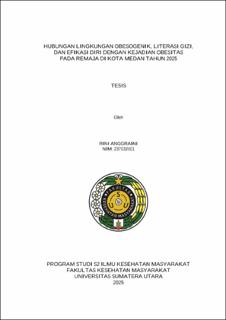| dc.contributor.advisor | Sudaryati, Etti | |
| dc.contributor.advisor | Aritonang, Evawany Yunita | |
| dc.contributor.author | Anggraini, Rini | |
| dc.date.accessioned | 2025-07-28T04:39:37Z | |
| dc.date.available | 2025-07-28T04:39:37Z | |
| dc.date.issued | 2025 | |
| dc.identifier.uri | https://repositori.usu.ac.id/handle/123456789/107615 | |
| dc.description.abstract | Obesity is a risk factor for non-communicable diseases, with its prevalence among adults in Indonesia continuing to rise. It is projected to reach 50 percent by 2030 if no effective interventions are implemented. Preventive efforts during adolescence are crucial, as adolescents with obesity are at a high risk of becoming obese adults. This study aims to analyze the relationship between obesogenic environments, nutrition literacy, and self-efficacy with the incidence of obesity among senior high school adolescents in Medan City in 2025. The study employed a matched case-control design with a 1:1 ratio, in which age and sex were used as matching variables. The total sample consisted of 100 adolescents in the case group and 100 in the control group. Bivariate analysis using McNemar's test showed significant associations between family obesogenic environment (p = 0.008), interactive nutrition literacy (p < 0.001), total self-efficacy (p = 0.007), self-efficacy toward healthy eating behavior (p = 0.004), and self-efficacy toward maintaining a healthy body weight (p < 0.001) with obesity incidence. Binary logistic regression analysis revealed that the most dominant factor associated with obesity was self-efficacy toward healthy body weight (OR = 4.855), indicating that adolescents with low self-efficacy toward healthy body weight are at a higher risk of obesity compared to those with high self-efficacy toward healthy body weight. Adolescents with a highly obesogenic family environment, low interactive nutrition literacy, low total self-efficacy, and low self-efficacy toward healthy body weight had an 89.5 percent likelihood of becoming obese. These findings highlight the importance of obesity prevention strategies focusing on improving adolescents' nutrition literacy and self-efficacy, along with fostering a supportive family environment for healthy living. | en_US |
| dc.language.iso | id | en_US |
| dc.publisher | Universitas Sumatera Utara | en_US |
| dc.subject | Obese adolescents | en_US |
| dc.subject | Obesogenic | en_US |
| dc.subject | Literacy | en_US |
| dc.subject | Efficacy | en_US |
| dc.title | Hubungan Lingkungan Obesogenik, Literasi Gizi, dan Efikasi Diri dengan Kejadian Obesitas pada Remaja di Kota Medan Tahun 2025 | en_US |
| dc.title.alternative | The Relationship Between Obesogenic Environment, Nutrition Literacy, and Self Efficacy with The Incidence of Obesity Among Adolescents in Medan City in 2025 | en_US |
| dc.type | Thesis | en_US |
| dc.identifier.nim | NIM237032001 | |
| dc.identifier.nidn | NIDN0001096504 | |
| dc.identifier.nidn | NIDN0016056809 | |
| dc.identifier.kodeprodi | KODEPRODI13101#Ilmu Kesehatan Masyarakat | |
| dc.description.pages | 209 Pages | en_US |
| dc.description.type | Tesis Magister | en_US |
| dc.subject.sdgs | SDGs 3. Good Health And Well Being | en_US |


